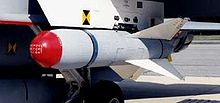Walleye missile
| AGM-62 Walleye | |
|---|---|

AGM-62 Walleye loaded on board an aircraft.
|
|
| Type | Glide bomb |
| Place of origin | United States |
| Service history | |
| In service | 1960s - 1990s |
| Used by | United States Armed Forces |
| Wars |
Vietnam War Gulf War |
| Production history | |
| Manufacturer | Martin Marietta |
| Variants |
|
| Specifications | |
|
|
|
|
Launch
platform |
|
The AGM-62 Walleye is a television-guided glide bomb which was produced by Martin Marietta and used by the United States Armed Forces during the 1960s. Most had a 250 lb (113 kg) high-explosive warhead; some had a nuclear warhead. The designation of the Walleye as an "air-to-ground missile" is a misnomer, as it is an unpowered bomb with guidance avionics, similar to the more modern GBU-15. The Walleye was superseded by the AGM-65 Maverick.
The Walleye was the first of a family of precision-guided munitions designed to hit targets with minimal collateral damage. This “smart bomb” had no propulsion system, but it could be maneuvered via a television assisted guidance system during its glide from an aircraft to the target. As a pilot dove towards a target, a television camera in the nose of the bomb transmitted images to a monitor in the cockpit. Once the pilot acquired a sharp image of the target on his screen, he designated an aim point and released the bomb, which would continue flying toward the designated target on its own. The bomb was a true fire-and-forget system because once launched, the plane could immediately turn away from the aim point. The Walleye maneuvered itself using four large fins. Later versions employed an extended range data link that let pilots keep flying the weapon after its release, and even change aim points during flight (command guidance).
The idea of a TV guided bomb came out of discussions between an eclectic group of civilian engineers at the Naval Ordnance Test Center (later the Naval Weapons Center) at China Lake, California. One of the engineers, Norman Kay, built televisions in his home as a hobby. Kay built an iconoscope camera in 1958 that could do a “funny thing,” recalled fellow project engineer William H. Woodworth. “It occurred to him that he could build a little circuit into there that would put a little blip in the picture, and he could make the little blip track things that would move in the picture.” The two engineers, soon joined by Dave Livingston, Jack Crawford, George Lewis, Larry Brown, Steve Brugler, Bob (Sam) Cunningham and several others, decided to research the idea further and quickly secured some seed money from the Navy to advance the concept. Adopting some technology from the AIM-9 Sidewinder air-to-air missile project and developing other components from scratch, the group developed the bomb in just four years. Among other revolutionary breakthroughs, the group developed the world’s first solid-state television camera with no vacuum tubes and the first zero-input-impedance amplifier.
...
Wikipedia
